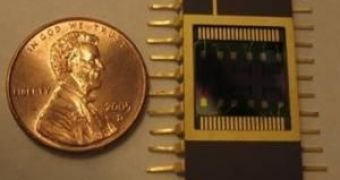Most substances used in suicidal terrorist attacks are usually home made, that's why it is necessary that security enforcement benefit from the help of a small sensor to detect traces left behind by these chemicals. One of the commonest home made explosives is hydrogen peroxide. Researchers from the University of California claim that they have been able to create a penny-sized electronic sensor capable of detecting traces of hydrogen peroxide in concentrations as low as a few parts-per-billion.
Alternatively, the chip integrated detector could also be used in industrial applications to monitor the concentration of toxic substances workers are routinely exposed to.
"The detection capability of this tiny electronic sensor is comparable to current instruments, which are large, bulky and cost thousands of dollars each. If this device were mass produced, it's not inconceivable that it could be made for less than a dollar," said William Trogler from University of California's Science Division.
How it works
The chip integrated sensor detector created by the University of Calofornia consists of a metal phthalocyanine which, when exposed to oxidizing agents, suffers an increase in electrical current through its mass. The reverse effect is experienced when exposed to reducing agents. With hydrogen peroxide, however, the sensor shows preferential behavior in relation to the metal used to create the phthalocyanine films.
For example, metal cobalt phthalocyanine films suffer decreases in current, while copper and nickel metals determine an increase in electrical current. During the experiments conducted at UCSD, both constructive configurations were tested, each displaying a unique signature when small amounts of hydrogen peroxide was detected.
Terrorist threat
According to authorities, 50 people died due to hydrogen peroxide bombs, and 14 times more people were injured during the terrorist attacks in London Underground, in mid 2005. Nearly 700 kilograms of hydrogen peroxide based explosive were found in Germany last year, ready to be used in terrorist attacks.
The sensor is unaffected by the presence of water vapors in the atmosphere, thus it can be used in industrial applications as well. The university is now expecting the patent for the invention to be licensed, so the sensor to be sent into mass production.

 14 DAY TRIAL //
14 DAY TRIAL //